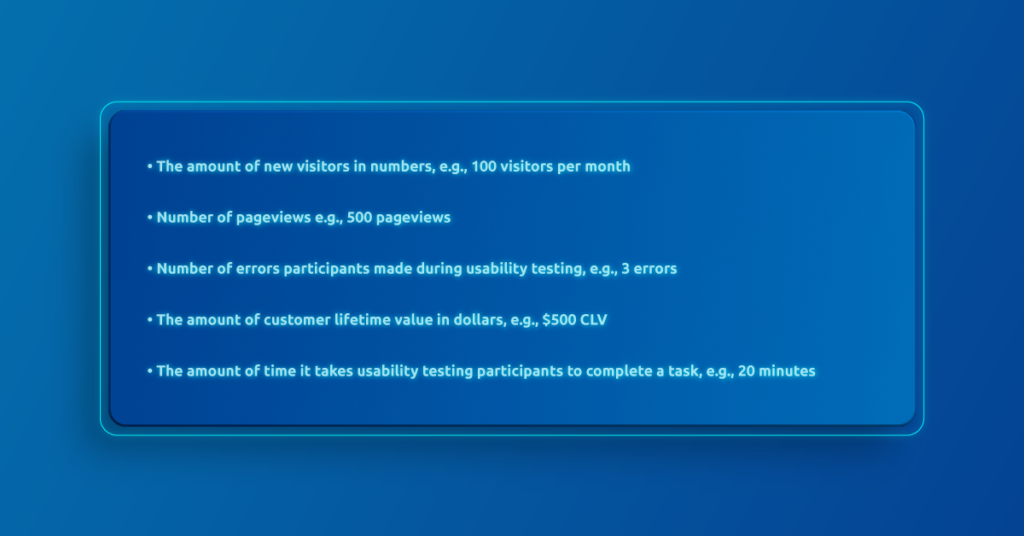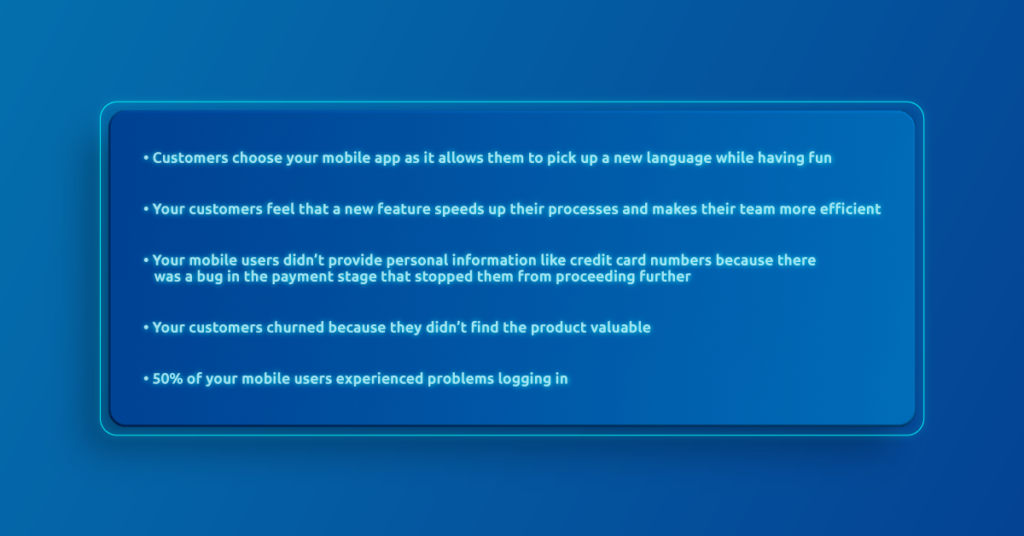What are the significant differences between quantitative and qualitative data? If you’re here, there’s a good chance this question bugs you. The good news is that you’ll get answers to this question, and more, throughout this article.
If you’re interested in how qualitative and quantitative analysis applies to business, then you won’t want to miss the second and third sections.
Table of contents:
- What is the difference between qualitative and quantitative analysis?
- What is quantitative data analysis: goals and the general approach in business settings
- What is qualitative data analysis: goals and the general approach relating to business
What is the difference between qualitative and quantitative analysis?
Generally speaking, quantitative data refers to anything you can quantify or measure. On the other hand, qualitative data refers to anything descriptive or that adds context to your business analysis.
Compare qualitative and quantitative analysis using the table below. It will give you a short but clear overview of the key differences between both types of business analysis.
Quantitative analysis
- Typically used in a probability-based sample size
- Used in hypothesis testing — a later research phase
- Generalizable
- Used for quantification. Answers “How many,” “How often,” “When,” and “What”
- Typically refers to numerical, non-descriptive data
- Quantitative data can usually be collected faster and is easier to analyze
- Lacks context and detail
- Objective in nature
Qualitative analysis
- Typically used in a non-probability-based sample size
- Used in hypothesis generation — an earlier research phase
- Non-generalizable
- Used to describe. Answers “Why” and “How”
- Typically refers to non-numerical data that’s descriptive
- Qualitative data is usually time-consuming to collect and analyze
- Rich in context and detail
- Subjective in nature
For a more detailed comparison, read our first article about qualitative and quantitative research methods.
Although the comparison is clear, we’d like to address an important nuance. Most online resources describe qualitative and quantitative data in very specific terms. But the devil’s in the details. Let’s allow two of our experts to explain what this nuance is all about:
“The terms qualitative and quantitative refer more to the type of research. You analyze the data to draw conclusions from it.
Data is not qualitative or quantitative. You can collect ‘categorical’ data and analyze it quantitatively, and you can ask for ‘numeric’ data and analyze it qualitatively.
In a recent research project, I asked employees how big their companies were. They told me a specific number. I used this number to better understand the context in which this person works, but I wasn’t doing any statistical analysis with them.
I did qualitative research even though the data is ‘numerical.’
In the app onboarding flow, we ask people about their role — they can answer ‘UX designer‘ or ‘Developer‘ and so on. But I might be trying to do some statistics with this data and conclude something like, ‘50% of our users have product-focused roles.‘
In this situation, I would be doing quantitative research even though the data is ‘categorical’.”
Andrej Kiripolský, Senior UX Researcher at Grafana Lab
“There is this misconception about quantitative data — that anything numbers-related is quantitative.
But that’s not the case. When we talk about quantitative research, we are mostly talking about data which can be used for inference.
For example, say I ask a group of people how many of them drink coffee. Let’s say I found that 80 people out of 100 drink coffee. That’s a number — but it’s not quantitative data — it’s just a description.
Descriptive data without statistical significance, even if it has numbers, does not constitute quantitative data.”
Aditi Paul, PhD, Mixed-methods researcher, LinkedIn profile
You still can operate on both qualitative and quantitative data terms. Just keep in mind that experienced data professionals will refer to qualitative and quantitative research projects and analysis rather than “data” itself.
What’s more, seasoned data professionals usually know the purpose of their analysis, including what obstacles they may encounter along the way. For this reason, numerical data is sometimes collected for additional context. It’s also why professionals sometimes collect descriptive data but analyze it statistically.
Now, let’s jump to the second and third sections. They examine the use of quantitative and qualitative data analysis in business settings.
What is quantitative data analysis: goals and the general approach in business settings
In this section, we’ll look at 5 practical examples of quantitative data analysis, including the overall goal of the analysis and how a business can use this type of data to its advantage. Let’s begin with a short definition of quantitative data.
Quantitative data typically refers to data that you can count or measure. As mentioned in the previous section, you can collect data qualitatively and quantify it. Quantitative data collection methods include online surveys, probability sampling, interviews, questionnaire observations, and document reviews.
5 examples of quantitative data in business settings
First, let’s look at a few examples:

Now, let’s look at how you can use quantitative data in a business setting. You’ll learn about the goal of quantitative analysis, including the general approach to this data type among business professionals.
What is the goal of quantitative analysis: what does it mean for businesses?
A quantitative approach can provide your business with a lot of value. It’s better to make decisions based on data over hunches.
The main goal of quantitative data analysis is to:
- Confirm a hypothesis — to measure or quantify a phenomenon by testing various hypotheses
- Set causality — quantitative analysis aims to explore the relationship between independent and dependent variables
“First of all, quantitative datasets are everywhere, but there are few things you need to remember when playing with quants:
- Ensure the initial measurement is taken in the right way. As they say, shit in = shit out. If your Google Pixel doesn’t track the events correctly or your margins are calculated incorrectly, there is not much you can do
- Track and flag the data points, keep the documentation and repository of ‘what is what’ to help new people working with datasets. It saves a lot of time
- Keep in mind to track changes in your data calculations. Visual software such as Alteryx or Tableau may help with creating logical and easy-to-understand data flows which you can modify and work with
As for making the most out of the data, keep it simple but maintain rigor. In other words, don’t push for creating multilinear regression models if you don’t really get how the correlation works. In other words, applying the wrong method is worse than not doing anything.”
Maciej Wilczynski, Managing Partner at Valueships
Now, let’s see some examples of how various parties approach quantitative data in business.
A general approach to quantitative data in business
There is a slight tendency to prefer measurable, quantitative data over qualitative data. Take G2 for example — they state “Because quantitative data and structured data go hand-in-hand, quantitative data is generally preferred for data analysis.” Our subject matter expert also acknowledges this tendency.
It might be because numbers, charts, and stats seem to convince people more than stories and qualitative data.
With this approach, businesses should rely on quantitative data to:
- Understand existing business trends
- Identify problems and patterns
- Allocate resources for business projects
- Evaluate the future value of products
- Assess their bottom line
As historical data is a key asset for many industries, companies will want access to large amounts of data and have the option to analyze it. It’s not uncommon for business leaders to value quantitative data over qualitative data as this approach is often taught in university. Let’s take a closer look.
“I got my PhD from a university which was purely quantitative, to the point that they completely demonized qualitative research. They were like, ‘This is what we do, you’re going to learn quantitative, and going to learn it well.
So I was from the get-go, I was trained to think in numbers, and it didn’t really help that I got my bachelor’s and master’s in computer science. So that really drove my mind to work in analytical ways.
And one of the other reasons why quantitative research gets so much clout in the industry, as well as in the academic space, is because it’s easier to publish quantitative research when you put numbers and statistically significant results.
And it becomes much more persuasive versus qualitative and saying that: ‘Oh, I interviewed five people, and these are their stories.’ As powerful as those stories are, they require compelling writing, and moving results to see the light of day.
In quantitative research, you just have a bunch of variables, and you can just crunch the numbers and you can bring up some p value which is less than 0.05, you will at least get the attention of a reviewer.”
Aditi Paul, PhD, Mixed-methods researcher, LinkedIn profile
In regard to quantitative analysis in business, it seems that many companies rely on numerical methods in the first place. In the next section, you’ll learn more about the value of the qualitative approach.
What is qualitative data analysis: goals and the general approach relating to business
In this section, we’ll look at 5 practical examples of qualitative data analysis, including the goal of the analysis and how businesses can use this type of data for best results.
First, let’s start with a short definition of qualitative data. Qualitative data is non-statistical in nature — it’s subjective. It’s descriptive and has an unstructured or semi-structured form. You can classify qualitative data based on properties, attributes, labels, and other identifiers. Qualitative data collection methods include focus groups, case studies, and ethnography.
5 examples of qualitative data in business settings

Now, let’s look at how you can use qualitative data in a business setting. You’ll learn about the goal of qualitative analysis, including the general approach favored by business professionals.
What is the goal of qualitative analysis and what does it mean for businesses?
A qualitative approach can provide your business with lots of value as it adds context to numerical data. As a result, your business has a better chance of understanding explored phenomena.
The main goal of qualitative data analysis is to:
- Explore — to generate insights and knowledge
- Understand — to add context to quantitative data
“I would assert that qualitative research methods are malleable, adapting to the reactions and responses of participants as they arrive.
As the research session progresses, researchers can inquire about respondents’ reasons for preferring certain products over others, providing the company with a more nuanced understanding of their customers’ perceptions of their products.
During a research session for a forthcoming film, the data collected indicates that respondents have relatively neutral feelings about ending A and ending B.
A skilled qualitative researcher can quickly modify the survey by asking participants to elaborate on the aspects of endings A and B that appeal to them. The film studio can then create an ending that incorporates the positive aspects of both endings.”
SumitBansal, Founder & Managing Director at TrumpExcel.com
Now, let’s see some examples of how various parties approach qualitative data as it relates to business.
A general approach to qualitative data in business
“No great marketing decisions have ever been made on qualitative data,” said John Sculley. This opinion doesn’t put qualitative data in a good light. But let’s keep in mind that technological advancement has made it easier than ever to gather qualitative data and make the right decisions with it.
Take Brené Brown for example. All of her groundbreaking studies are based on qualitative research. She proved that qualitative research has big potential and value if you know how to use it. All you need is a skilled data professional to help.
Let’s see what our expert has to say about the value of qualitative analysis.
“Qualitative data tells you the ‘why’ behind quantitative data. For example, quantitative data informs you about a landing page’s drop off rate. But you don’t know why people drop off. Qualitative data lets you understand why, so you know what to do to fix the problem.
There is a false belief that a data collection method is either qualitative or quantitative.
The truth is that one method can be both quantitative and qualitative. For example, the famous Net Promoter Score (NPS) survey. The first question on the NPS survey is quantitative because it asks you to rate, from 0 to 10, if you’d recommend a business. The second question of the NPS survey is qualitative because it asks you, ‘what’s the reason for your score.’“
George Gavrila, Marketing Director at Survicate
In summary, qualitative data and analysis opens new possibilities for your business projects and gives you a more complete picture of the phenomenon you’re analyzing. If your business currently depends on quantitative data, consider adding more context with qualitative data.
Combine quantitative and qualitative data for best results
While some sources say that one approach is better than the other, we’ve decided to take a different path.
After interviewing seasoned data professionals, we’ve concluded that qualitative and quantitative analysis complement each other and should go hand-in-hand.
The best thing you can do is marry the qualitative and quantitative approach to make the best decisions for your business. You’ll understand what your customers do and why by doing so.












